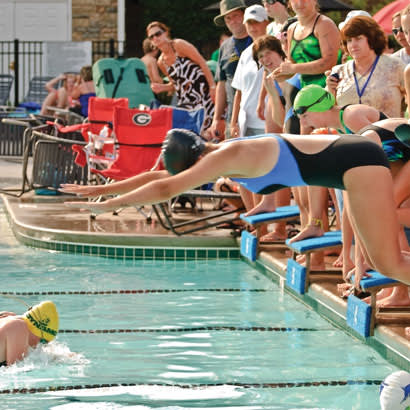
The starter calls out, “Swimmers…take your mark,” the horn sounds, and for the aquatics director there’s the realization that he or she is almost at his or her own “finish line.” It’s the last leg of their long-distance relay race through logistical planning sessions, staff training, facility setup and equipment testing, complete with individuals and groups with various skills, abilities and perspectives about how this event should be done. The goal is to host an event where the logistical planning and details go unnoticed by the participants and spectators, resulting in a positive perspective on the event and the host facility.
Like many in the aquatics industry, my 30 years of experience began with summer swimming leagues. At the core, this is as simple as aquatic event planning gets: make sure stopwatches are working, coaches have a lineup, a parents group is running the concession stand, and there are countless awesome volunteers to assist with everything from timing and judging, to scorekeeping and trying to control kids as they wait for the race. Wearing the facility director hat, there are added staffing, equipment care, and water chemistry issues to monitor. And, at the completion of the event, it’s making sure everything is put away so it can all be done again another day.
So, what has really changed? The basic idea of the swim meet is still there; however, the world around the event has changed. Most of the planning and processes come down to two areas: safety and operational readiness.
Safety
Safety used to mean making sure someone on deck had some level of lifeguarding experience or certification. It focused primarily on the athlete experience and on ensuring that for all involved the event entrance and regress happened without incident. The main considerations were equipment functionality and water quality, with the spectator experience being a close second.
In 1988, after American diver Greg Louganis hit his head on the board at the Olympics, the focus on safety changed. Incidents like this had happened before (Louganis in 1979), but it was the 1988 incident that was most witnessed and remembered. As a result, facilities looked closer at participant safety and having emergency action plans at the ready.
The focus would remain on athlete safety until September 11, 2001, when spectator safety was included in the conversation. Drawing on the expertise of local law enforcement and security companies, a layer of security was added that directly influenced some logistical planning. Over time, this layer has become seamless within our operation. Spectators, participants and facility staff have all come to expect bag checkers, metal detectors and K-9 sweeps of the facilities prior to the start of an event. For the facility director, this extended planning and focus on safety has resulted in a few more hours of logistical planning and an increase in the costs related to hosting the event. However, we never truly stop asking the same basic question, “Can we improve safety for those who attend this event?”
Operational Readiness
A staff member once asked me, “What do we need to be ready for?” My response is simple, “everything.” I would argue that operational readiness is a delicate balance between paranoia and preparedness. Many of the things we improve and add to our process are things that have “gone wrong” in past events: things we can laugh about now, but did not even consider smiling about as we experienced them.
In my early years, we needed working stopwatches, a starter’s pistol, lane lines, backstroke flags and volunteers to operate them. In the years since, we have added timing systems, replaced the starter’s pistol with a starter’s horn and added a display to show the competitors’ progress to the spectators. The meet, which once used to take as long as it needed to complete the event, now has a system that manages every second of the event, with swimmers waiting in the water while the next race starts.
Much like safety, we look for things that can go wrong: weighing the chances and probabilities for each element, and planning accordingly; using what we learned from past events to improve on the next. In one instance, it was a swimmer in pre-race stretching who jumped up hitting the support wire for the backstroke flags. The support hook snapped, causing the backstroke flags to “gently flutter” down onto the surface of the water. Watching this unfold, like in a slow-motion horror movie, we quickly tried to find a solution. While we hope this never happens again, we have developed processes to prevent this type of incident from affecting the event.
So, we test and retest timing equipment and backups, review procedures with staff about the entry of meet personnel and how to care for them should a situation arise, and conduct walk-throughs with law enforcement and security. There is training for facility staff and reviewing and revising of emergency action plans. Through it all, the facility director has a unique perspective of the competitive event. As the sights and sounds of the event fade and the equipment is stored, there is only time to pause briefly before resuming the planning process for the next event.
There are several questions and considerations in the planning process for aquatic competitive events (here's a handy checklist). Whether it’s a summer swim league dual meet or collegiate championship event, the scale may differ, but the desire is to have each element operate like a well-oiled machine, ready and firing on all cylinders for the day of the event.
Joe Wakeley is the Assistant Director, Campus Recreation Aquatic Center at Ohio University.

